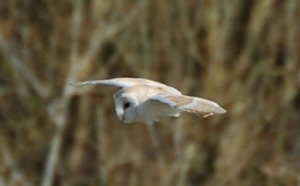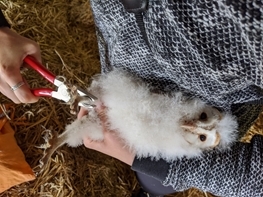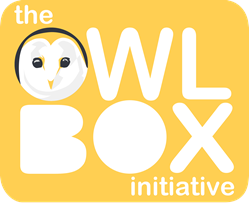 Barn owls are a beautiful, elusive species typical of lowland farmland in Britain. The Owl Box Initiative (OBI) was set up to help support barn owls by providing nest boxes for them on farms and researching barn owls’ farmland habitat use across the south west of England. This fact sheet explores their ecology and conservation needs.
Barn owls are a beautiful, elusive species typical of lowland farmland in Britain. The Owl Box Initiative (OBI) was set up to help support barn owls by providing nest boxes for them on farms and researching barn owls’ farmland habitat use across the south west of England. This fact sheet explores their ecology and conservation needs.
Background
Where do barn owls live?
Barn owls are found in relatively open landscapes, often on lowland farmland across Britain where their main prey species thrive. They are not a woodland or urban species although, perhaps more than other owl species, they are comfortable living in relatively close proximity to humans and are commonly found using barns or deserted buildings for roosting and nesting.
What habitat do they need?
Barn owls prefer open rough grassland where their prey of small mammals can be found in high densities, predominantly voles, mice, and shrews. They may also hunt along field margins, the edge of woodlands, watercourses or even roads, and any other grassy areas1-3. Set-aside strips around fields that are planted with tussocky grasses1 could also provide good hunting areas, along with beetle banks4. Studying this aspect of their hunting behaviour in a farmed landscape will be part of the OBI.
How do they hunt?
Barn owls usually hunt at night, with some activity at dawn and dusk. Their light body and large wings with comb-like fringed edges mean they can fly slowly and silently, searching for prey on the ground. Barn owls have excellent hearing, with the unmistakeable heart-shaped face, which acts as a disc and focuses sound to the ears, while their long legs help them to catch their prey through long grass. Barn owls catch and kill their prey with their talons, rather than their beak, then eat the item whole, regurgitating the indigestible parts in a pellet at a later time5,6. These pellets contain bones, fur, etc and are often found at roosting sites. They can give valuable information about what has been eaten, and are therefore very useful for ecologists studying owl diet7.
Breeding
Where do barn owls nest?
 Barn owls nest in cavities – either within mature trees, which can be situated within fields, in hedgerows or on the edge of woodland adjacent to open land, or by using ledges in old agricultural buildings. Natural nesting sites are more limited now, following the removal of many mature hedgerows and conversion of old farm buildings, but barn owls have adapted well to nesting in boxes provided for them. It is thought that many barn owl pairs – perhaps more than a quarter of those nesting in the UK – now use nest boxes5.
Barn owls nest in cavities – either within mature trees, which can be situated within fields, in hedgerows or on the edge of woodland adjacent to open land, or by using ledges in old agricultural buildings. Natural nesting sites are more limited now, following the removal of many mature hedgerows and conversion of old farm buildings, but barn owls have adapted well to nesting in boxes provided for them. It is thought that many barn owl pairs – perhaps more than a quarter of those nesting in the UK – now use nest boxes5.
When do they breed?
Courtship begins over winter, and by early spring pairs spend much of their time at the nesting site. The male and female will cement their bond by cheek rubbing and preening, while the male increases his hunting activity to feed the female. This increases her weight in readiness for breeding, when on average she will lay 4-6 eggs onto a base of pellets. These are laid at intervals – one every two to three days – over an 8-21-day period; incubation begins when the first egg is laid (unlike many other bird species, which start incubating when all eggs have been produced), therefore each egg in the clutch are slightly different ages and hatch at different times.
After around 30 days of incubation by the female, eggs begin to hatch one at a time, so the demand for an increased food supply is spread out over a longer period. There can often be a three-week age difference between the youngest and oldest chick, and when food is scarce the youngest is likely to starve. By 8-9 weeks barn owls have attempted their first flight, and by 10-11 weeks old many owlets will now look like adults and will be attempting to hunt for themselves.
Where do the young go?
Young barn owls disperse from their nest, and look for a home range with abundant prey, roosting and nesting sites as well as a possible mate. The distance they travel from their fledging site to find their new home depends on how available these key factors are in the vicinity. The size of the area they need is partly dependant on how plentiful the food supply is, and home ranges can vary from as little as 350 up to 5,000 hectares. Barn owls are not particularly territorial, and home ranges often overlap with neighbouring individuals.
Barn owl numbers
How many barn owls are there in the UK?
The most recent estimate suggested that there were 4,000 barn owl pairs in the UK8, but this was based on surveys from 1995 to 1997 and we don’t have more recent robust data. The barn owl was far more common at the beginning of the 20th century than it is today, but numbers have recovered from a low point during the 1970s and 1980s and may now exceed 10,000 breeding pairs5. Barn owls were moved from the amber to the green list for conservation concern in 2015 for this reason, but there is still much that can be done to help support them.
What do barn owls need?
Like many bird species, barn owls need a reliable, safe, food supply and suitable nesting sites. Barn owls do not have a long life expectancy in the wild, typically living around four years if they survive their first year9. However, well over half of barn owl chicks die in the first year6,10.
What are the main threats to barn owls?
For nestlings, juveniles in their first year and adults in winter, starvation is thought to be the main cause of death. Survival is controlled largely by food supply, which is dependent on other factors such as the availability of enough good quality habitat for hunting as well as the weather6. Lack of food in winter because of severe weather can have a dramatic impact on barn owls, with extreme weather leading to population crashes10. Some of the adaptations that allow barn owls to fly silently mean that their feathers are less waterproof than other birds, so they rarely hunt in poor weather. The loss of rough grasslands in favour of more intensively farmed fields and the relative scarcity of stubble fields in modern farming now that autumn crops are common means fewer small mammals, and less good hunting habitat for barn owls7,11.
Other threats to barn owls come directly from human activity. For example, their relatively low hunting flight means that collisions with vehicles can often happen where roads have suitable hunting strips flanking them but are not screened by hedges or trees, which force the owls up and over the road, rather than flying across at a low level. Agricultural chemicals, including pesticide seed dressings and rodenticides, may also have had an impact on barn owl populations and this may be an ongoing problem in some areas12.
What can be done to support barn owl conservation?
Barn owls need both hunting habitat and nest sites. The first can be addressed by land managers creating strips or patches of rough tussocky grassland at least 4m wide, with a litter layer of dead grass, at least 7cm deep; this will encourage the barn owl’s prey species and therefore help support the owls themselves. Barn owl nest boxes can also be sited in suitable locations to increase nesting opportunities. A GWCT project focusing on promoting barn owl conservation also aims to understand how barn owls use agricultural habitats, particularly those associated with agri-environment Schemes (AES), which is relatively unknown.
The Owl Box Initiative
What is the Owl Box Initiative?
 The Owl Box Initiative (OBI) is a GWCT project to support barn owls across the south west of England, funded by the Green Recovery Challenge Fund, providing nest boxes and advice to the local community on suitable box designs, where to site and when to put up a nest box, as well as monitoring how the owls are using their habitat are all important parts of the project. Our scientists are working across 100 farms covering 40,000 hectares to inspire farmers and communities about barn owl conservation.
The Owl Box Initiative (OBI) is a GWCT project to support barn owls across the south west of England, funded by the Green Recovery Challenge Fund, providing nest boxes and advice to the local community on suitable box designs, where to site and when to put up a nest box, as well as monitoring how the owls are using their habitat are all important parts of the project. Our scientists are working across 100 farms covering 40,000 hectares to inspire farmers and communities about barn owl conservation.
The project has distributed and mounted 50 new nest boxes, and these will be monitored along with existing nest boxes in the study area, for occupancy, breeding success and survival in the 2021 breeding season. Some adult barn owls will be monitored using GPS tags, which will record their movements and give valuable tracking data.
One of the project aims is to help us understand how barn owls use agri-environment scheme habitats, and this GPS tracking will contribute to a much broader knowledge of barn owl habitat use in the modern farmed environment. Studying which AES habitats barn owls choose to use, while monitoring how well they are doing, will help tell us which methods are best to support barn owls and guide conservation efforts. The scientists will also monitor prey species in the area, and study barn owl diet through analysing pellets.
We hope that sharing these results with farmers and landowners will encourage them to include more barn owl friendly habitat on their land, which will benefit the barn owls themselves but also many other species.
For more information on the Owl Box Initiative, please visit the website.
References
- Askew, NP, Searle, JB & Moore, NP. (2007) Agri-environment schemes and foraging of barn owls Tyto alba. Agriculture, Ecosystems and Environment, 118: 109–114
- Bond, G, Burnside, NG, Metcalfe, DJ, Scott, DM & Blamire, J. (2005) The effects of land-use and landscape structure on barn owl (Tyto alba) breeding success in southern England, U.K. Landscape Ecology, 20: 555–566
- Tome, R & Valkama, J. (2001). Seasonal variation in the abundance and habitat use of Barn Owls Tyto alba on lowland farmland. Ornis Fennica 78:
- Boatman, ND, Stoate, C & Watts, & PN. (2000) Practical management solutions for birds on lowland arable farmland. Ecology and Conservation of Lowland Farmland Birds, 105–114
- British Trust for Ornithology. Barn Owl. Available at: https://www.bto.org/our-science/projects/project-owl/learn-about-owls/barn-owl
- The Barn Owl Trust. Barn owl facts. Available at: https://www.barnowltrust.org.uk/barn-owl-facts/
- Love, RA, Webon, C, Glue, DE, Harris, S & Harris, S. (2000) Changes in the food of British Barn Owls (Tyto alba) between 1974 and 1997. Mammal Review, 30: 107–129
- Toms, MP, Crick, HQP & Shawyer, CR. (2001) The status of breeding barn owls tyto alba in the United Kingdom 1995–97. Bird Study, 48: 23–37
- Hawk and Owl Trust. Barn owl. Available at: https://hawkandowltrust.org/about-birds-of-prey/barn-owl
- Altwegg, R, Alexandre, AE, Ae, R, Kestenholz, M & Jenni, L. (2006) Demographic effects of extreme winter weather in the barn owl. Oecologia, 149: 44–51
- Robinson, RA & Sutherland, WJ. (2002) Post-war changes in arable farming and biodiversity in Great Britain. Journal of Applied Ecology, 39: 157–176
- Stoate, C, Boatman, ND, Borralho, RJ, Rio Carvalho, C, de Snoo, GR & Eden, P. (2001) Ecological impacts of arable intensification in Europe. Journal of Environmental Management, 63: 337–365